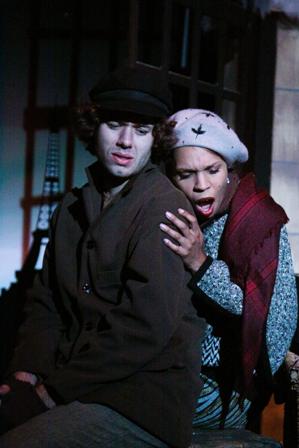|
Symphony
SRS SEASON ENDS WITH RESOUNDING TA-TA-TA-BANG
by Terry McNeill
Sunday, June 1, 2025
Symphony
YOUTHFUL VIRTUOSITY ON DISPLAY AT USO'S MAY CONCERTS
by Peter Lert
Saturday, May 17, 2025
Symphony
MYSTICAL PLANETS AND LIVELY GERSHWIN ORTIZ AT FINAL SRS CONCERT
by Peter Lert
Sunday, May 4, 2025
Symphony
VSO'S CONCERT MUSIC OF TIME, MUSIC OF PLACE
by Peter Lert
Sunday, April 27, 2025
Choral and Vocal
VOCAL ELEGANCE AND FIRE AT THE 222'S RECITAL APRIL 26
by Pamela Hicks Gailey
Saturday, April 26, 2025
CANTIAMO SONOMA SINGS AN INSPIRED GOOD FRIDAY MOZART REQUIEM CONCERT
by Pamela Hicks Gailey
Friday, April 18, 2025
DRAMATIC SHOSTAKOVICH SYMPHONY CLOSES PHILHARMONIC'S 25TH SEASON
by Terry McNeill
Sunday, April 13, 2025
LARGE COLLEGE OF MARIN AUDIENCE GREETS STOPHER ARTISTRY
by Terry McNeill
Saturday, April 5, 2025
Chamber
FRISSON DELIVERS SHIVERS OF DELIGHT
by Abby Wasserman
Sunday, March 30, 2025
OLD AND MOSTLY NEW IN SRS MARCH CONCERT IN WEILL
by Peter Lert
Saturday, March 22, 2025
|
 |
 Will Hart Meyer and Leslie Sandefur in "La Bohème" |
ARDENT CHEMISTRY IN CINNABAR'S PUCCINI OPERA
by Elaine Trowbridge
Friday, November 6, 2009
Puccini’s “La Bohème” continues to be one of the most popular operas of all time, a verismo tale of impoverished young artists and writers living in Paris’ Latin Quarter. It opens as they confront the challenges of staying warm and paying the rent. These problems are handled with great humor, spontaneity, and clever manipulation of the vocal lines. but dramatic difficulties are found in their romantic relationships. The poet Rodolfo meets Mimi as her candle goes out and she loses her room key. He surreptitiously finds the key, relights the candle and their love is ablaze. Their sweet and gentle love-at-first sight contrasts with the tempestuous affection between the painter Marcello, Rodolfo’s best friend, and the fiery courtesan Musetta. All live moment to moment, celebrating life and friendship at the Café Momus while Marcello and Musetta torment one another by inciting each other’s jealousies and romantic chemistry. Later, Rodolfo laments as his relationship with Mimi takes a tragic turn for the worse.
This highly entertaining Donald Pippin adaptation, currently being performed in Cinnabar Theater's 37th season (the run closes Nov. 21), offers a great opportunity to experience the operatic art form in a slightly abridged and more accessible version. It should appeal to a wide audience, is sung in English, and the story can be followed without the need to read distracting supertitles. The disadvantage of the Pippin adaptation is that the original libretto is more poetic and flowing in the native Italian. The intimate, rustic venue of the Cinnabar Theater offers a realistic location in which the story can unfold, the audience in close proximity to the action, and the musical experience is more personal and direct than in a large opera house.
The updating of the original 1830 ambiance to 1927 is effectively captured in Scott Barringer’s sets, with large reproductions of floor to ceiling posters by Alphonse Mucha, a prominent artist who depicted sensual women in the “Art Nouveau” style. As the stage is two-tiered for each act, the design gives the company ample room to move rapidly in all directions. The colorful costumes have been correspondingly modernized by Wardrobe Mistress Lisa Eldredge, and particularly flamboyant is the multicolored flapper-style outfit worn by Musetta.
The performers are young and energetic, appealing in their portrayals in the lead roles. Particularly convincing is Todd Donovan as Marcello, entrapped in a stormy love affair with the volatile Musetta, hilariously vamped by Julia Hathaway. In calm contrast is the tender romance of Rodolfo and Mimi. Rodolfo’s passion, interpreted by William Hart Meyer, appears more restrained as does that of Leslie Sandefur’s Mimi. Ms. Sandefur’s rich vocal gifts provide the emotional power and delicate sensitivity needed to carry the role, and her upper range was delightful. Schaunard and Colline, humorously sung by Eugene Walden and William O’Neill, respectively, provide the comic relief needed to sustain us as the tragedy unfolds.
The orchestra, capably led by Nina Shuman, sounded surprisingly rich considering it numbered just nine musicians and a pianist. The Philharmonique de Paris performed the score, first heard in Turin in 1896, with rich color and a broad dynamic range. The enthusiastic supporting cast, including child acrobats and chorus, made the Café Momus scene in the second act festive and thoroughly amusing.
Ultimately, this production of “La Bohème” succeeded on many levels. And who has not known characters like these under-funded, romantic artists and intellectuals? Perhaps the “bohemians” might remind us of our years as young college students. However the story might resonate with our past, all will find much to enjoy in this elegant new Cinnabar production.
Critic Bev Kjeldsen contributed to this review
|
